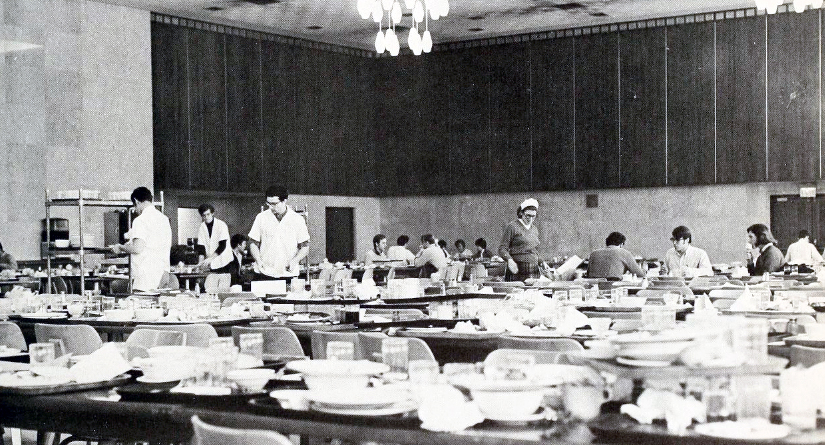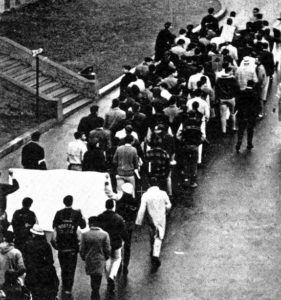
Before the change in food service, resident students just left their trays, plates, glasses, etc., for workers to remove, which resulted in some messy tables.
“One cannot think well . . . if one has not dined well” — Virginia Woolf
In spring 1966, the issue of the food served in the McElroy dining hall came to a boil. On Sunday, March 27, the dinner meal consisted of a breaded veal cutlet grinder with tomato sauce. Maybe it was that bread-on-bread factor, maybe something else. According to coverage in The Heights, it started with “a long, soaring milk carton.” No more than a minute later, the dining hall was “littered with un-eaten food and overturned chairs.”
The damage was greater than that, at least according to the recollection of classmate Brian Froelich. “I was sitting next to [classmate] Len Persin. Lenny was a big [6-4, 260] strong end on the football team who was later drafted by the Philadelphia Eagles. But he was very quiet and reserved. When the food fight broke out there was food flying all over the place. I stopped eating and ducked down to avoid the chaos and flying food. Lenny never said a word, never ducked, and never stopped eating. It was like nothing was happening. Then a bowl of green jello hit him right in the chest, on his clean shirt. He didn’t say a word, stood up, flipped the table over sideways, and then (rather than going to the aisle) walked straight ahead flipping over the half-dozen tables between him and the door. Tables, food, and people went flying. Lenny left the room without saying a word and I sat there amazed, laughing. It was an unforgettable sight.”
Classmate Carmine Sarno: “I can still see pads of butter speared by straws and rocketed to the ceiling where they nested. There were hundreds of them. It was a riot.”
(If it had happened these days, we’d have tons of videos of it to watch. No such luck.)
The resident students’ actions on that March evening were not the first reactions to the question of the quality of the food in McElroy. The previous December, “Hundreds of students complained of stomach cramps, gas pains and diarrhea as a result of the food served at the McElroy banquet,” reported The Heights. Investigations followed, and BC said it was unable to find a specific cause for the illnesses. (I always thought it was the “jus” on the roast beef au jus.)
Maybe because we had seen other students protesting and demonstrating, usually about much more significant matters, but April 1966 saw a series of acts of “disobedience” and marches to argue for change. These were arranged and directed by an “Ad Hoc Committee” that included classmate Peter Driscoll, the lone sophomore among seven members on the committee.
Classmate Gerry Shea, managing editor of The Heights, reported on the situation thoroughly in his article “We Shall Eat Good Food” in the April 6, 1966, edition. He described the actions of resident men seeking change as a “first” at BC. On the evening following Sunday’s “riot,” “a large number” of resident students entered the dining hall five minutes before closing. This required the dining hall’s “chow line” to remain open 20 minutes past the usual 6 pm closing. The next night, Tuesday, “approximately 600 students” arrived at McElroy shortly before closing and formed one serving line instead of the normal three. This forced the chow line to stay open until 7:10 pm, more than an hour beyond normal closing. Later that night, at an open meeting of the Council of Resident Men, it was announced that BC President Michael Walsh, SJ, would meet Thursday with the Ad Hoc Committee.
On Wednesday, a crowd of resident men gathered in late afternoon at Cheverus Hall and formed a procession that marched to St. Mary’s Hall, despite steady rain (photo, at left). There, the students presented a letter “requesting immediate changes in the food system” and sang “We shall eat good food” to the tune of We Shall Overcome.
The changes weren’t exactly immediate, but Fr. Walsh told the Ad Hoc Committee Thursday that four national food services would be visiting campus the next day and would then submit bids to operate all food services on campus. The new operation was expected to be in place no later than May 1.
Saga Food Service won the bid and actually took over the food service operation later in April. Saga instituted changes, as reported in the April 29 Heights, “Food conditions improve as students stomach Saga.“ Students now were to bus their own trays, but in exchange . . . “The students are, at times, perplexed with the plethora of selections.”


I’m glad I was a commuter. Nothing like Mom’s meals every night!